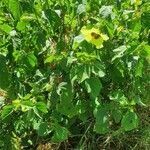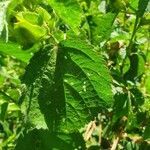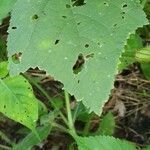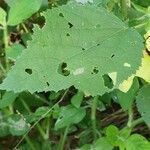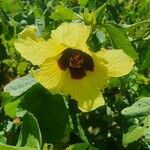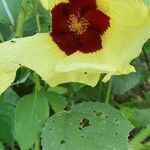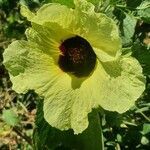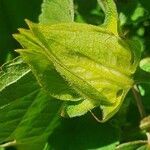Leaf-lamina up to 12 × 12 cm., suborbicular in outline, obscurely or distinctly 3–5-lobed, stellate-pubescent or stellate-pilosulose above, stellate-pubescent or stellate-pilose or stellate-tomentose beneath, apex acute, margin serrate, base cordate or subcordate; petiole usually up to 9 (18) cm. long, stellate-pilose; stipules up to 15 mm. long, filiform or subsetaceous, somewhat expanded at the base.
A herb. It grows about 50-200 cm tall. It keeps growing from year to year. The leaves are almost round but with 3 lobes. They are heart shaped at the base and there are teeth along the edge. The leaves are about 19 cm across. The leaf stalks are 5 cm long. The flowers are bell shaped and yellow. They are about 6 cm across and have a dark red centre. The fruit are dry and break open into segments.
Perennial herb or shrub, up to 3 m high. Leaves with blade suborbicular to broadly ovate, 3-5-lobed, up to 120 x 120 mm. Flowers: calyx lobes ovate to narrowly ovate; 5 segments of epicalyx variously shaped but usually broadened somewhere near middle; petals up to 60 mm long, yellow with brownish or dark red centre; Nov.-Apr.
Perennial herb or shrub, up to 3 m high. Leaves subcir-cular to ovate in outline, 3-lobed. Calyx lobes ovate to lanceolate. Bracts of epicalyx variously shaped but usually broadened somewhere near middle. Flowers yellow with brownish or dark red centre.
Epicalyx of 5 bracts, stellate-pubescent; bracts up to 18 mm. long, varying greatly in shape but nearly always broadest near the middle then narrowed suddenly to a caudate tip which is a prolongation of the midrib, joined for 3–4 mm. at the base.
Flowers up to 12 cm. in diam., yellow usually with a brownish or dark red centre, solitary, axillary; peduncle c. 7 (10) mm. long, stellate-pubescent, usually rather inconspicuously articulated near the base.
Calyx up to 16 mm. long, stellate-tomentellous; lobes ovate to ovate-lanceolate, usually 3-nerved, joined to nearly half-way.
Shrub or perennial herb up to 3 m. tall; stems tomentose or pubescent when young, later glabrescent.
Petals up to 6 × 4·5 cm., obliquely obovate, pubescent outside, glabrous within.
Staminal tube up to 15 mm. long; free parts of filaments 1·5–3 mm. long.
Capsule 25 × 15 mm., ellipsoid; valves aristate.
Seeds 3 × 2·5 mm., subreniform, tomentellous.
Style-branches 4–5 mm. long.
